IQuS Publications
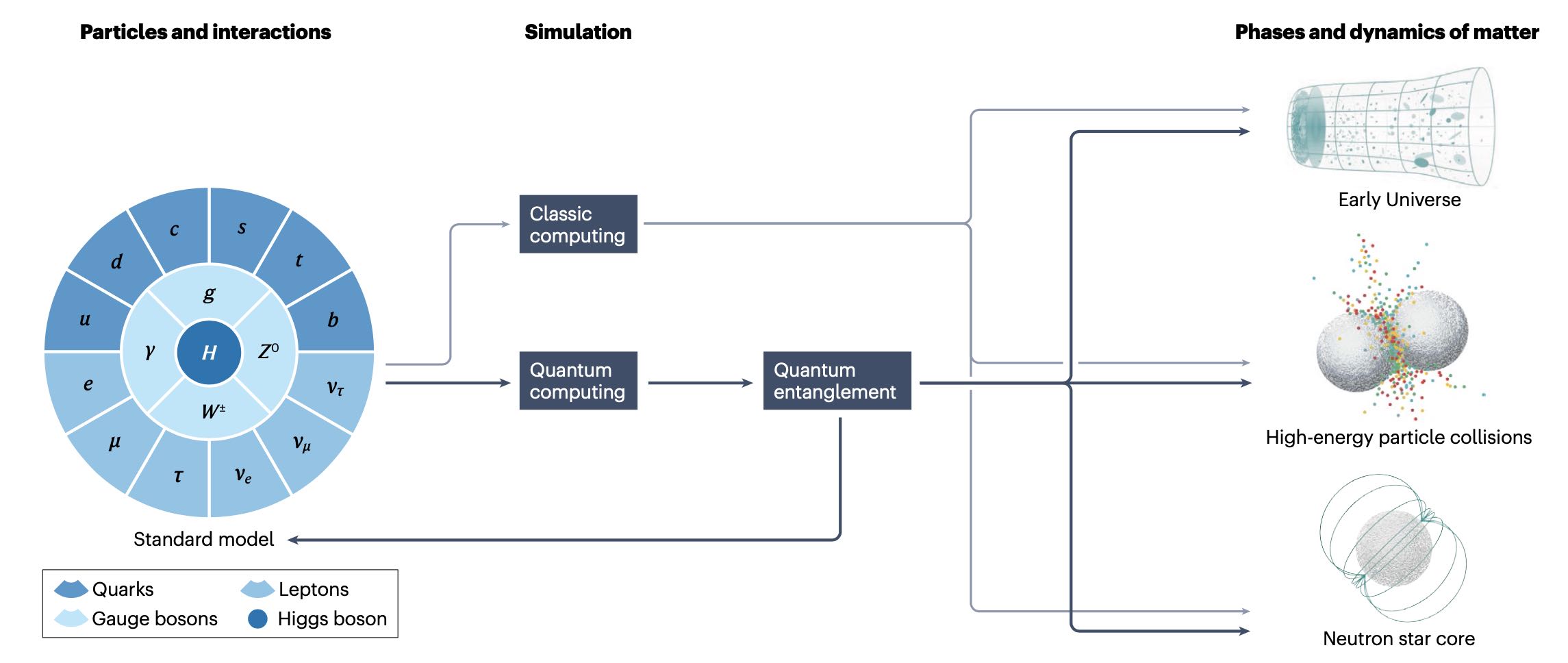
Quantum simulation of fundamental particles and forces
Key static and dynamic properties of matter — from creation in the Big Bang to evolution into subatomic and astrophysical environments — arise from the underlying fundamental quantum fields of the standard model and their effective descriptions. However, the simulation of these properties lies beyond the capabilities of classical computation alone. Advances in quantum technologies have improved control over quantum entanglement and coherence to the point at which robust simulations of quantum fields are anticipated in the foreseeable future. In this Perspective article, we discuss the emerging area of quantum simulations of standard-model physics, outlining the challenges and opportunities for progress in the context of nuclear and high-energy physics.

Real Time Quarkonium Transport Coefficients in Open Quantum Systems from Euclidean QCD
Recent open quantum system studies showed that quarkonium time evolution inside the quark-gluon plasma is determined by transport coefficients that are defined in terms of a gauge invariant correlator of two chromoelectric field operators connected by an adjoint Wilson line. We study the Euclidean version of the correlator for quarkonium evolution and discuss the extraction of the transport coefficients from this Euclidean correlator, highlighting its difference from other problems that also require reconstructing a spectral function, such as the calculation of the heavy quark diffusion coefficient. Along the way, we explain why the transport coefficient gamma(adj) differs from gamma(fund) at finite temperature at O(g^4), in spite of the fact that their corresponding spectral functions differ only by a temperature-independent term at the same order. We then discuss how to evaluate the Euclidean correlator via lattice QCD methods, with a focus on reducing the uncertainty caused by infrared renormalons in determining the renormalization factor nonperturbatively.
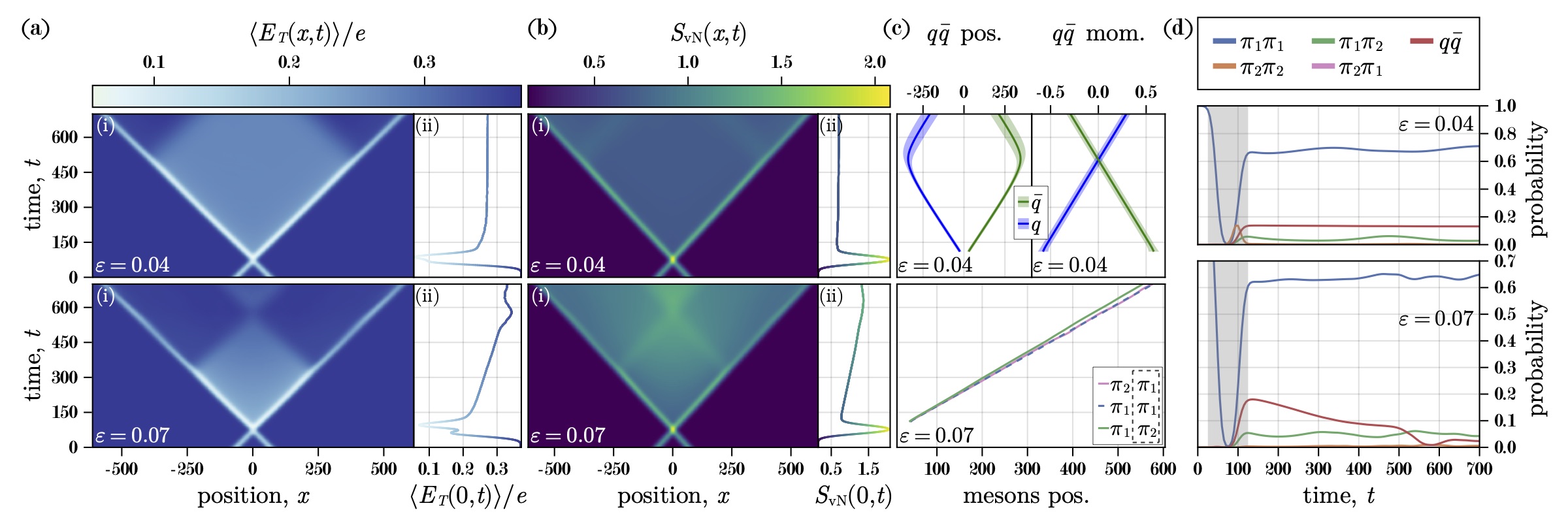
High-energy Collision of Quarks and Hadrons in the Schwinger Model: From Tensor-Networks to Circuit-QED
With the aim of studying nonperturbative, out-of-equilibrium dynamics of high-energy particle collisions on quantum simulators, we investigate the scattering dynamics of lattice quantum electrodynamics in 1+1 dimensions. Working in the bosonized formulation of the model, an analog circuit-QED implementation is proposed that is native to the platform, hence requires minimal ingredients and approximations, and enables practical schemes for particle wavepacket preparation and evolution. Furthermore, working in the thermodynamic limit, uniform-matrix-product-state tensor networks are used to construct multi-particle wavepacket states, evolve them in time, and detect outgoing particles post collision. This facilitates the numerical simulation of scattering experiments in both confined and deconfined regimes of the model at different energies, giving rise to rich phenomenology, including inelastic production of quark and meson states, meson disintegration, and dynamical string formation and breaking. Elastic and inelastic scattering cross sections are obtained, together with time-resolved momentum and position distributions of the outgoing particles. This study highlights the role of classical and quantum simulation in enhancing our understanding of scattering processes in quantum field theories in real time.
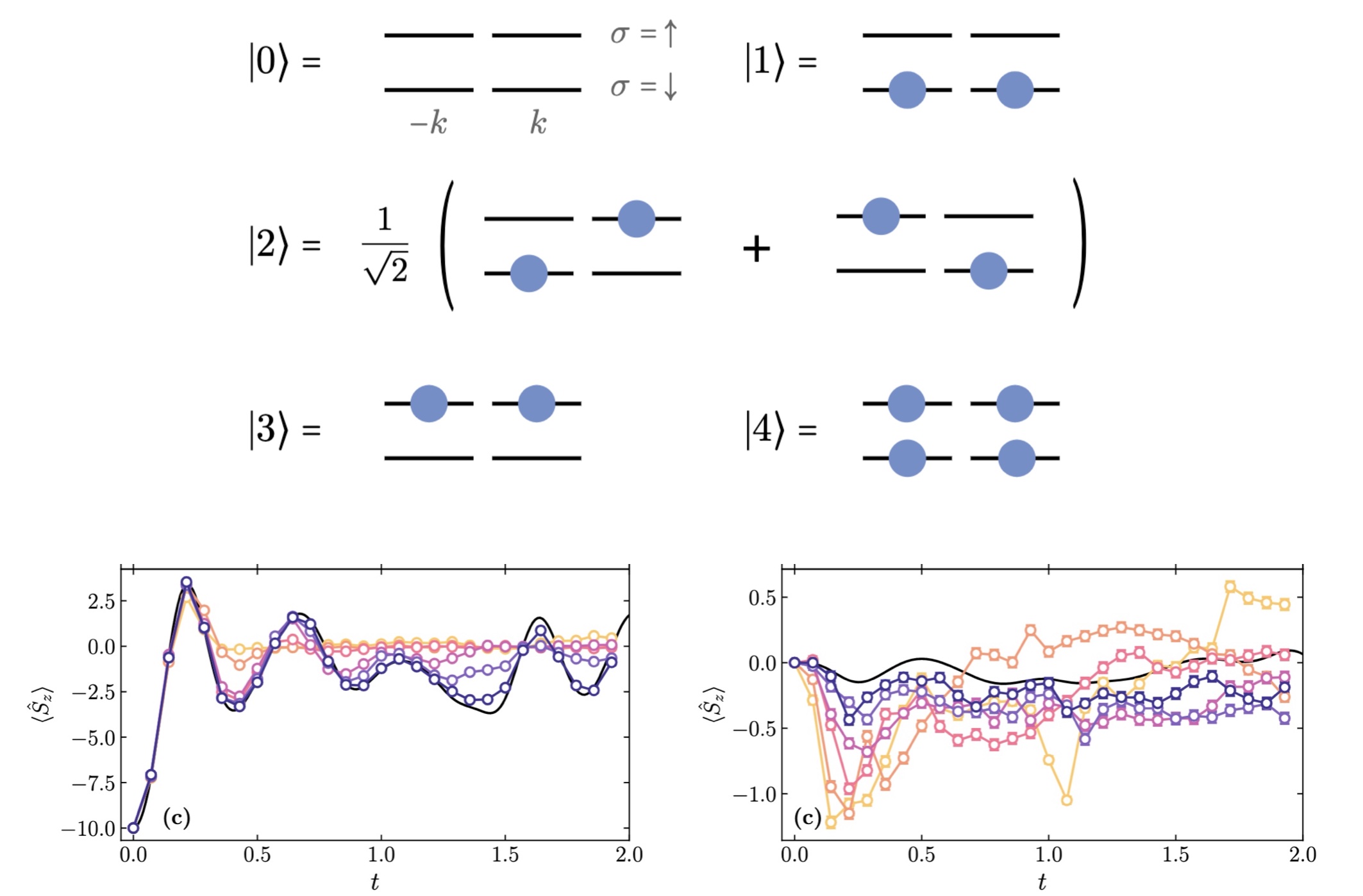
Quantum Simulations of SO(5) Many-Fermion Systems using Qudits
The structure and dynamics of many-body systems are the result of a delicate interplay between underlying interactions. Fermionic pairing plays a central role in various physical systems and can lead to collective phenomena such as superconductivity and superfluidity. We explore the potential utility of quantum computers with arrays of qudits in simulating interacting fermionic systems, when the qudits can be naturally mapped to the relevant degrees of freedom. The Agassi model of fermions is based on an underlying $so(5)$ algebra, and the systems it describes can be partitioned into pairs of modes with five basis states, which naturally embed in arrays of $d=5$ qudits (qu5its). Classical noiseless simulations of the time evolution of systems of fermions embedded in up to twelve qu5its are performed using Google’s {\tt cirq} software. The resource requirements of the qu5it circuits are analyzed and compared with two different mappings to qubit systems, a physics-aware Jordan-Wigner mapping and a state-to- state mapping. We find advantages in using qudits, specifically in lowering the required quantum resources and reducing anticipated errors that take the simulation out of the physical space. A previously unrecognized sign problem has been identified from Trotterization errors in time evolving high-energy excitations. This has implications for quantum simulations in high energy and nuclear physics, specifically of fragmentation and highly inelastic, multi-channel processes.
This work was supported, in part, by Universität Bielefeld and ERC- 885281-KILONOVA Advanced Grant (Robin), by U.S. Department of Energy, Office of Science, Office of Nuclear Physics, InQubator for Quantum Simulation (IQuS) under Award Number DOE (NP) Award DE-SC0020970 (Savage), and the Quantum Science Center (QSC), a National Quantum Information Science Research Center of the U.S. Department of Energy (Illa).
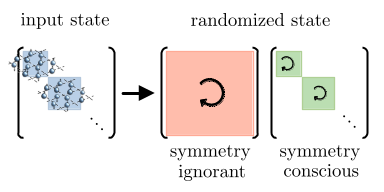
Randomized measurement protocols for lattice gauge theories
Randomized measurement protocols, including classical shadows, entanglement tomography, and randomized benchmarking are powerful techniques to estimate observables, perform state tomography, or extract the entanglement properties of quantum states. While unraveling the intricate structure of quantum states is generally difficult and resource-intensive, quantum systems in nature are often tightly constrained by symmetries. This can be leveraged by the symmetry-conscious randomized measurement schemes we propose, yielding clear advantages over symmetry-blind randomization such as reducing measurement costs, enabling symmetry-based error mitigation in experiments, allowing differentiated measurement of (lattice) gauge theory entanglement structure, and, potentially, the verification of topologically ordered states in existing and near-term experiments. Crucially, unlike symmetry-blind randomized measurement protocols, these latter tasks can be performed without relearning symmetries via full reconstruction of the density matrix.
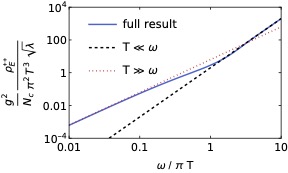
Chromoelectric field correlator for quarkonium transport in the strongly coupled N=4 Yang-Mills plasma from AdS/CFT
Previous studies have shown that a gauge-invariant correlation function of two chromoelectric fields connected by a straight timelike adjoint Wilson line encodes crucial information about quark-gluon plasma (QGP) that determines the dynamics of small-sized quarkonium in the medium. Motivated by the successes of holographic calculations to describe strongly coupled QGP, we calculate the analog gauge-invariant correlation function in strongly coupled $\mathcal{N}=4$ supersymmetric Yang-Mills theory at finite temperature by using the AdS/CFT correspondence. Our results indicate that the transition processes between bound and unbound quarkonium states are suppressed in strongly coupled plasmas, and moreover, the leading contributions to these transition processes vanish in both the quantum Brownian motion and quantum optical limits of open quantum system approaches to quarkonia.
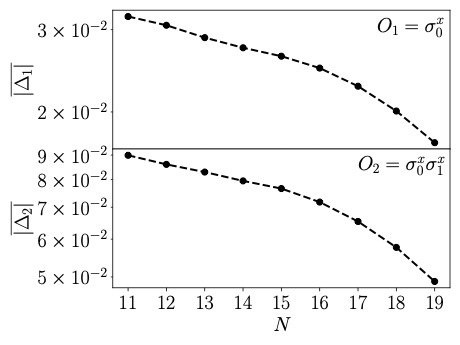
SU(2) Non-Abelian Gauge Theory on a Plaquette Chain Obeys Eigenstate Thermalization Hypothesis
We test the eigenstate thermalization hypothesis (ETH) for 2+1 dimensional SU(2) lattice gauge theory. By considering the theory on a chain of plaquettes and truncating basis states for link variables at j=1/2, we can map it onto an Ising chain and numerically exactly diagonalize the Hamiltonian for reasonably large lattice sizes. We find energy level repulsion in momentum sectors with no remaining discrete symmetries. We study two local observables made up of Wilson loops and calculate their matrix elements in the energy eigenbasis, which are shown consistent with the ETH. Our study implies a subset of states in the physical Hilbert space of Quantum Chromodynamics (QCD) obeys the ETH.
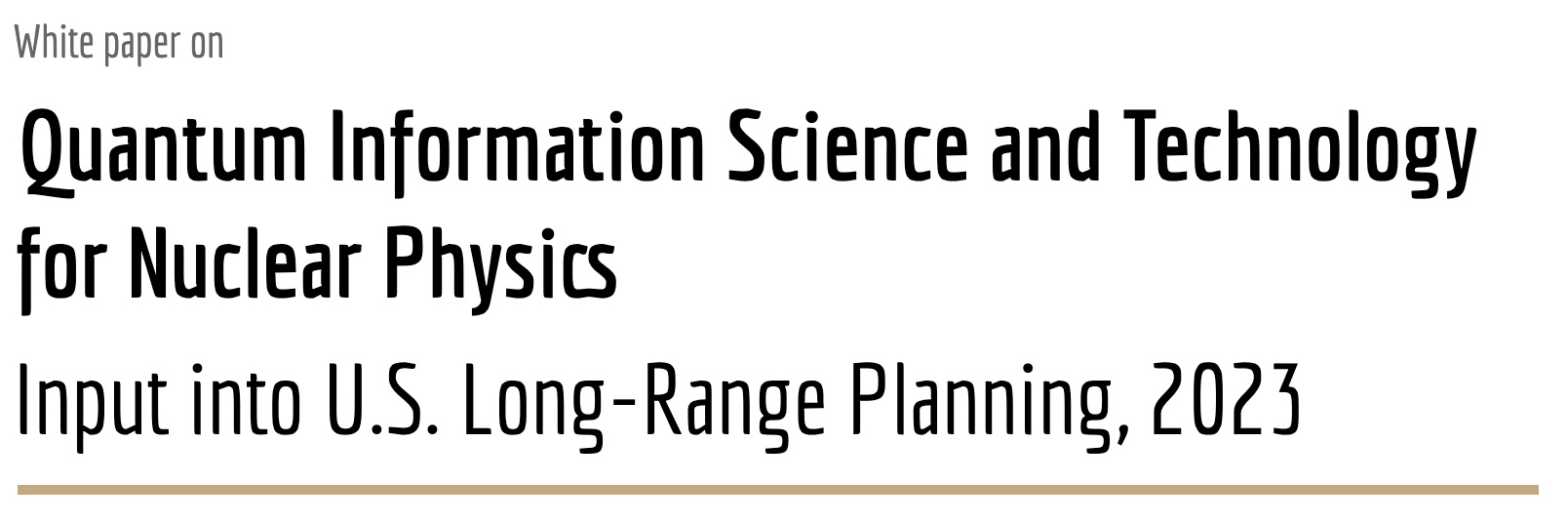
White paper on Quantum Information Science and Technology for Nuclear Physics. Input into U.S. Long-Range Planning, 2023.
In preparation for the 2023 NSAC Long Range Plan (LRP), members of the Nuclear Science community gathered to discuss the current state of, and plans for further leveraging opportunities in, QIST in NP research at the Quantum Information Science for U.S. Nuclear Physics Long Range Planning workshop [4], held in Santa Fe, New Mexico on January 31—Feb 1, 2023. The workshop, jointly-sponsored by Los Alamos National Laboratory (LANL) and the InQubator for Quantum Simulation (IQuS), included 45 in-person participants and 53 remote attendees. The outcome of the workshop identified strategic plans and requirements for the next 5-10 years to advance quantum sensing and quantum simulations within NP, and to develop a diverse quantum-ready workforce. The plans include resolutions endorsed by the participants to address the compelling scientific opportunities at the intersections of NP and QIST. These endorsements are aligned with similar affirmations by the LRP Computational Nuclear Physics and AI/ML Workshop, the Nuclear Structure, Reactions, and Astrophysics LRP Town Hall, and the Fundamental Symmetries, Neutrons, and Neutrinos LRP Town Hall communities.
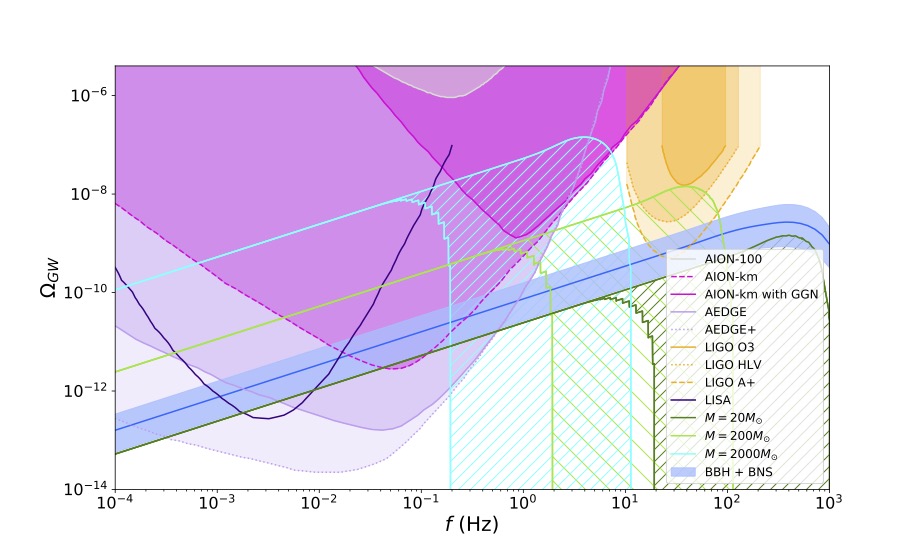
Gravitational Wave Backgrounds from Colliding ECOs
Long baseline atom interferometers offer an exciting opportunity to explore mid-frequency gravitational waves. In this work we survey the landscape of possible contributions to the total “gravitational wave background” in this frequency band and advocate for targeting this observable. Such an approach is complimentary to searches for resolved mergers from individual sources and may have much to reveal about the Universe. We find that the inspiral phases of stellar-mass compact binaries cumulatively produce a signal well within reach of the proposed AION-km and AEDGE experiments. Hypothetical populations of dark sector exotic compact objects, harbouring just a tiny fraction of the dark energy density, could also generate signatures unique to mid- and low-frequency gravitational wave detectors, providing a novel means to probe complexity in the dark sector.
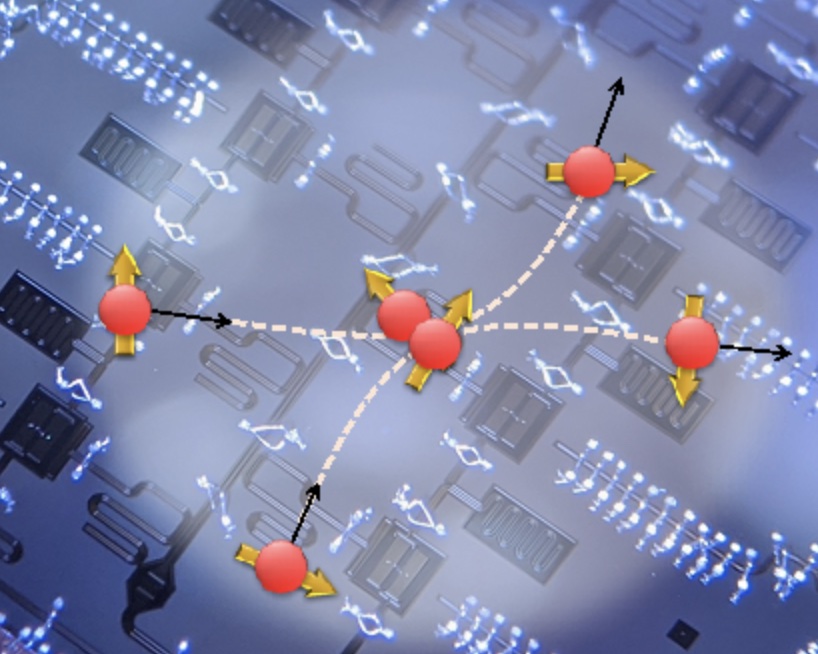
Demonstration of a quantum-classical coprocessing protocol for simulating nuclear reactions
Quantum computers hold great promise for arriving at exact simulations of nuclear dynamical processes (e.g., scattering and reactions) that are paramount to the study of nuclear matter at the limit of stability and to explaining the formation of chemical elements in stars. However, quantum simulations of the unitary (real) time dynamics of fermionic many-body systems require a currently prohibitive number of reliable and long-lived qubits. We propose a co-processing algorithm for the simulation of real-time dynamics in which the time evolution of the spatial coordinates is carried out on a classical processor, while the evolution of the spin degrees of freedom is carried out on a quantum processor. This hybrid algorithm is demonstrated in a quantum simulation of the scattering of two neutrons performed on the Lawrence Berkeley National Laboratory’s Advanced Quantum Testbed. We show that, after implementation of error mitigation strategies to improve the accuracy of the algorithm in addition to the use of either circuit compression techniques or tomography as methods to elucidate the onset of decoherence, this initial demonstration validates the principle of the proposed co-processing scheme. We anticipate that a generalization of this present scheme will open the way for (real-time) path integral simulations of nuclear scattering.
This work was supported in part by the U.S. Department of Energy, Office of Science, Office of Nuclear Physics, InQubator for Quantum Simulation (IQuS) under Award Number DOE (NP) Award DE-SC0020970 via the program on Quantum Horizons: QIS Research and Innovation for Nuclear Science. This work was prepared in part by LLNL under Contract No. DE-AC52-07NA27344 with support from the Laboratory Directed Research and Development Grant No. 19-DR- 005, and it was funded in part by the U.S. Department of Energy, Office of Science, Office of Nuclear Physics (under Work Proposal No. SCW1730), the Office of Advanced Scientific Computing Research Quantum Testbed Program (under Work Proposal No. FP00008338), and the Department of Energy National Nuclear Security Ad- ministration, Advanced Simulation and Computing Program.


